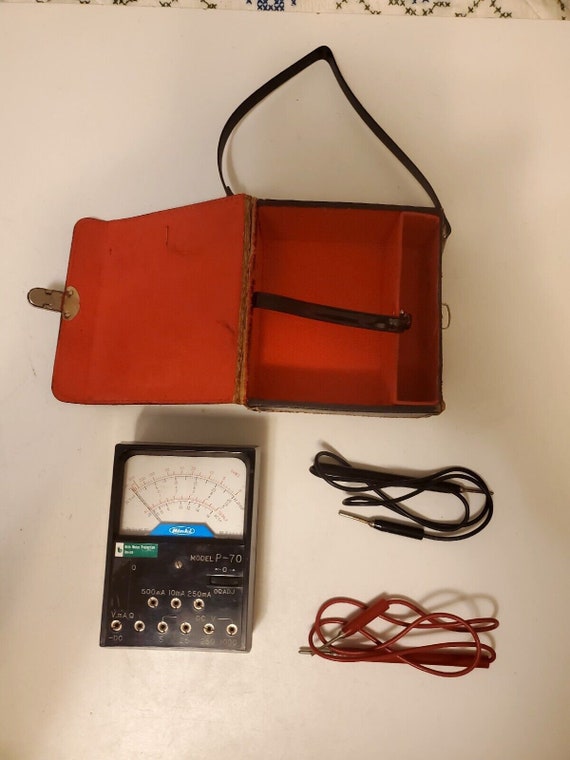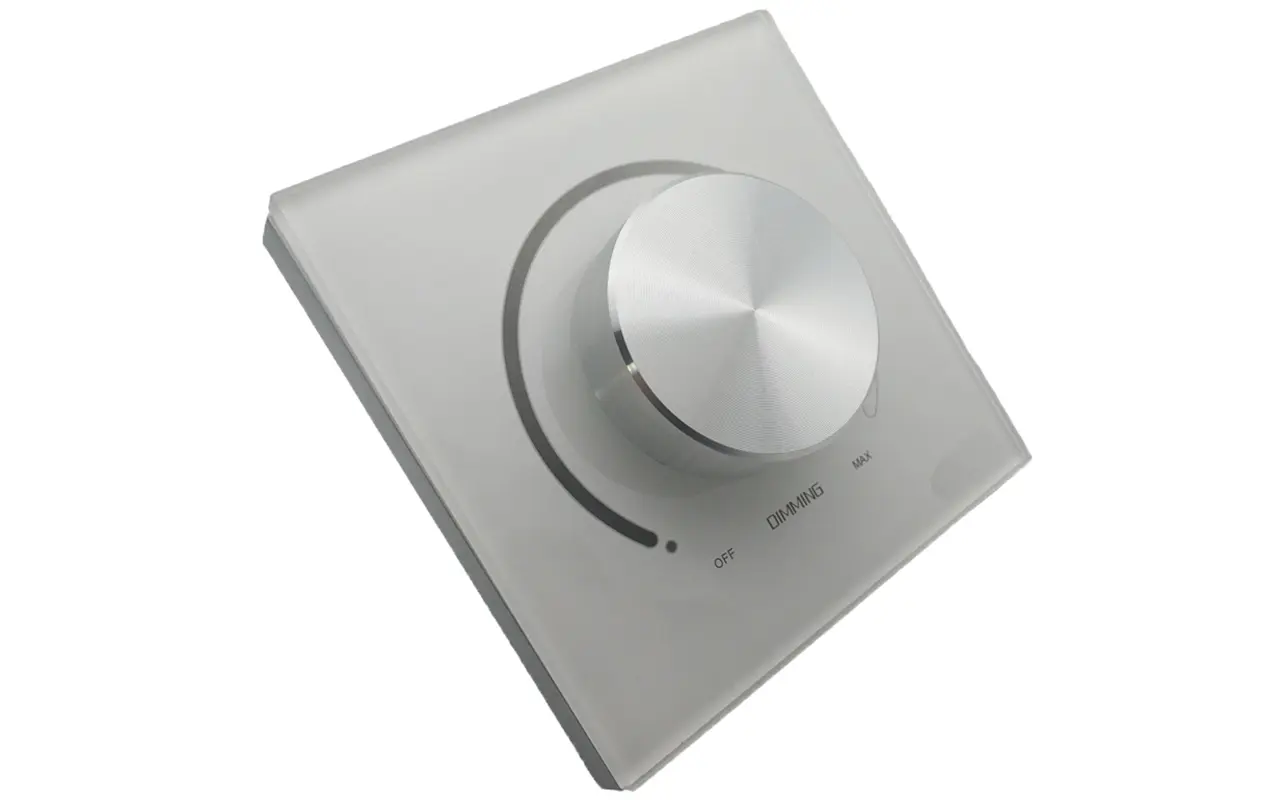Analog multimeters are electrical test instruments used to measure voltage, current, resistance, frequency, and signal power with a needle along a scale. While they are cheaper and more durable than digital multimeters, they are also less accurate and harder to read.
Nonetheless, technicians still use analog multimeters because they can easily show slow changes, making them more intuitive and easy to interpret compared to digital displays. Analog multimeters have been a mainstay in the electrical industry for many years. They use a needle that moves along a scale to indicate the measurement of the electrical parameter being tested.
Unlike digital multimeters, analog ones are less precise, harder to read, and more susceptible to interference and parallax errors. However, they are also cheaper, more durable, and responsive to changes, making them a popular choice for technicians who need to quickly identify changes in electrical readings. We will explore the advantages and disadvantages of analog multimeters and why technicians still use them today.

Credit: www.ebay.com
Analog Multimeter Vs. Digital Multimeter
An analog multimeter is an electrical testing device that measures voltage, current, resistance, frequency, and signal power using a needle along a scale. While cheaper and more responsive than digital ones, they are less accurate and harder to read, making them more challenging for beginners.
However, they are still preferred by some technicians due to their durability.
Comparison of Analog and Digital Multimeter Analog multimeters have been around for a long time, but digital multimeters have become more popular in recent years. While both types of multimeters can perform similar functions, there are some key differences to consider. Pros and cons of Analog Multimeter Analog multimeters have some advantages, such as being easy to use and not requiring batteries. They also often have a wider measurement range than digital multimeters. However, they can be difficult to read accurately and may not be suitable for measuring more complex electrical signals. Pros and cons of Digital Multimeter Digital multimeters are more precise than analog multimeters and can provide more accurate readings. They are also easier to read, especially for beginners. However, they require batteries and may not be as durable as analog multimeters. They also have a more limited measurement range. In conclusion, both types of multimeters have their pros and cons, so the choice between analog and digital ultimately depends on the specific needs of the user.
Applications Of Analog Multimeter
Analog multimeter is a versatile tool used for measuring electrical values such as voltage, current, resistance, and continuity. It is durable, responsive, and a cost-efficient alternative to digital multimeters. Despite being less accurate and hard to read for beginners, it is still used widely by technicians due to its reliability and affordability.
ck, simple, and reliable tools that have been widely used for decades in electrical testing and troubleshooting. One of the greatest advantages of analog multimeters is their versatility and range of applications. In this section, we will explore some of the common applications of an Analog Multimeter, including Testing Voltage, Measuring Resistance, Measuring Current, Frequency Measurement, and Signal Power Measurement.
Testing Voltage
One of the fundamental applications of an Analog Multimeter is testing voltage. This is achieved by connecting the multimeter’s test leads to the two points in a circuit where voltage is to be measured, and then setting the multimeter to measure voltage, based on the voltage level of the circuit being tested. To test voltage with an Analog Multimeter, it is essential to choose the appropriate range setting, which can be done through the multimeter’s range selector knob.
Measuring Resistance
Another important application of Analog Multimeters is the measurement of resistance. This is typically done by connecting the multimeter’s test leads across the two ends of the component or circuit being tested. When measuring resistance, it is essential to select the correct range setting on the Analog Multimeter to ensure accurate readings. Additionally, it is important to note that Analog Multimeters have limitations in measuring resistance, as they rely on the movement of a needle, which may be less precise than digital measurement.
Measuring Current
An Analog Multimeter can also be used to measure current. This application of the multimeter involves passing current through the multimeter itself, typically by connecting the multimeter in series with the component or circuit being tested. When performing current measurement, it is essential to select the correct range setting on the Analog Multimeter to ensure accurate readings. Analog Multimeters have ranges for measuring both AC and DC current, which makes them versatile in measuring current across a range of circuits.
Frequency Measurement
Analog Multimeters can also measure the frequency of electrical signals, by connecting the multimeter’s test leads to the component or circuit generating the signal. To measure frequency with an Analog Multimeter, it is important to first choose the correct range setting on the multimeter. It is worth noting that Analog Multimeters are not as precise as digital measurement tools in measuring frequency, but they provide a rough estimate of the frequency of the signal.
Signal Power Measurement
Analog Multimeters are also useful in measuring signal power. This application is particularly relevant in audio engineering and other fields where power measurement is relevant. To measure signal power with an Analog Multimeter, the multimeter’s test leads are connected to the output circuit, and the range selector knob is set based on the level of the current being measured. It is important to use caution when performing signal power measurement, as high power levels can damage the Analog Multimeter. In conclusion, Analog Multimeters have a wide range of applications, including voltage testing, resistance measurement, current measurement, frequency measurement, and signal power measurement. When using an Analog Multimeter, it is important to select the correct range setting and use caution to avoid damaging the multimeter or the circuit being tested. Although they may not have the precision and accuracy of digital measurement tools, Analog-Multimeters remain relevant and useful tools in electrical testing and troubleshooting.
How To Use Analog Multimeter
An analog multimeter is an electrical test instrument that measures voltage, current, resistance, frequency, and signal power. It uses a needle along a scale to provide readings and is cheaper and more durable than digital multimeters. Although less accurate and harder to read, analog multimeters are still preferred by some technicians for their responsiveness and simplicity.
How to Use Analog Multimeter Analog multimeters are handy tools for measuring voltage, current, and resistance. They are perfect for those who prefer a simpler, more traditional way of measuring electrical quantities. However, before using an analog multimeter, it’s important to know the different parts of the device and how to set it up correctly. In this post, we will cover everything you need to know about using an analog multimeter, including the parts of the device, how to set it up, how to select the testing range, checking the test leads, measuring voltage, current, and resistance, and reading and recording readings. Parts of Analog Multimeter An analog multimeter consists of several parts, each with its own function. Here are the main parts of the device: 1. Display Window: The display window shows the readings. 2. Scale: The scale displays measurement values. 3. Pointer: The pointer moves on the scale to indicate the readings. 4. Test Leads: Test leads are used to connect the multimeter to the circuit being measured. Setting up Analog Multimeter Before using an analog multimeter, you’ll need to set it up correctly. First, set the multimeter to the proper function – voltage, current, or resistance. Next, set the range of measurement that you want to read. Selecting Testing Range To select the testing range, turn the range selector dial until the desired range is displayed. It’s important to choose the appropriate range to avoid damaging the multimeter and to get an accurate reading. Checking the Test Leads Ensure the test leads are in good condition and not damaged. Any damage to the leads can lead to inaccurate readings. Then, connect the probes to the appropriate inputs on the multimeter. Measuring Voltage, Current, and Resistance To measure voltage or current, connect the test leads to the appropriate points in the circuit. To measure resistance, disconnect the circuit from the power source and touch the leads to the appropriate points in the circuit. Reading and Recording Readings After connecting the analog multimeter to the circuit, you can read the value directly from the scale. Carefully observe the pointer and the scale to get an accurate reading. You can then record the readings if necessary. In conclusion, using an analog multimeter requires a good understanding of its parts and proper setup. By following the steps outlined in this post, you can confidently use an analog multimeter to measure voltage, current, and resistance.
Tips For Beginners
Learning how to use an Analog Multimeter may seem daunting for beginners, but with the right approach, it can be a breeze. Analog Multimeters have been around for several decades, and they remain an essential tool for electronic engineers and technicians. These devices are used to measure voltage, current, resistance, frequency, and signal power. They are preferred by many professionals because of their reliability, accuracy, and the ability to provide real-time readings.
Familiarizing With Analog Multimeter
Before using an Analog Multimeter, it is essential to understand the device’s significant parts. It consists of a meter movement, a range switch, and a test lead. The meter movement shows the measurement readings in the form of pivoting needles. The range switch is used to select the measurement parameter, and the test lead is used to connect the device to the circuit being tested.
Safety Precautions
Safety is paramount when working with an Analog Multimeter. To prevent injury, the device must be used according to the manufacturer’s instructions. It is essential to check that all leads and cables are properly connected and insulated before use. If the device has a damaged or broken lead, it must not be used. It is also crucial to ensure that your hands are dry and free from moisture when working with live circuits.
Accuracy And Precision
Analog Multimeters’ accuracy and precision depend on the quality of the device and the user’s skill level. To ensure accurate readings, it is essential to select the appropriate measurement range and zero the meter before use. You can zero the meter by short-circuiting the test leads and adjusting the zero-ohm adjustment dial. It is also essential to handle the Analog Multimeter and the test leads with care to maintain the device’s accuracy and precision.
Calibration
Analog Multimeters require calibration to ensure they remain accurate. Calibration involves checking and adjusting the device to match a known standard. This process is crucial because Analog Multimeters’ accuracy can drift with time and frequent usage. It is recommended to calibrate your device at least once a year or when there are significant changes in temperature or humidity.
Mastering the Analog Multimeter may take some time, but with consistent practice and adherence to safety precautions, you can become proficient in using the device. With its ability to provide real-time readings, Analog Multimeters remain an essential tool for electrical engineers and technicians, and mastering their usage can give you a competitive edge in the industry.
Care And Maintenance
Maintaining an analog multimeter is crucial to ensure it functions efficiently and lasts longer. Regular calibration and cleaning of the components is recommended to prevent inaccurate readings and damage to the instrument. Store the multimeter in a dry and safe place to avoid any physical damage.
Cleaning And Storing Your Analog Multimeter
Keeping your analog multimeter clean and well-maintained is crucial for accurate readings and longevity. Dust and debris accumulation can interfere with the readings and damage the instrument. Here are a few tips to keep your analog multimeter clean:
- Wipe the surface of the multimeter with a soft, dry cloth after every use.
- To remove stubborn stains, use a damp cloth or alcohol wipes to gently clean the surface.
- Avoid using harsh chemicals or abrasive cleaners that may damage the surface.
- Ensure the test leads are clean and free of debris.
Proper storage is equally important to prevent damage and retain accuracy. Follow these steps:
- Store the multimeter in a dry and cool environment, away from direct sunlight and moisture.
- Wrap the test leads neatly around the instrument and secure them with rubber bands or clips.
- Place the multimeter in a protective case or box to prevent it from getting scratched or damaged during transportation.
Replacing Batteries
Analog multimeters require batteries to power the measurement circuit. When the battery is weak, the readings may become inaccurate or erratic. Here’s how to replace the batteries:
- Switch off the multimeter and remove the test leads.
- Locate the battery compartment on the back of the multimeter.
- Open the battery cover and remove the old batteries.
- Insert new batteries in the correct polarity, as indicated inside the compartment.
- Replace the battery cover and secure it tightly.
It’s best to replace all batteries at the same time to avoid uneven power supply.
Repair And Troubleshooting
Analog multimeters are simple instruments and require little maintenance. However, if you notice any malfunctioning, follow these steps:
- Refer to the user manual for troubleshooting tips and guidelines.
- Check the test leads for any signs of damage or wear and replace if necessary.
- Inspect the multimeter for loose connections, broken parts, or damaged wiring.
- Take the multimeter to a qualified repair technician for further diagnosis and repair if needed.
Avoiding Common Mistakes
Here are a few common mistakes to avoid while using your analog multimeter:
- Using the multimeter on a live electrical circuit, which can cause electric shock or damage the instrument.
- Using the multimeter on a wrong range setting, which can give inaccurate readings or damage the circuit.
- Applying excessive force on the test leads or the instrument, which can damage the wires or the internal components.
- Not calibrating the multimeter regularly, which can cause the readings to drift over time.
By following these care and maintenance tips, you can ensure that your analog multimeter is always accurate, reliable, and long-lasting.

Credit: www.symmetryelectronics.com
Recommendations
Analog multimeters are still used by technicians because they are more responsive and durable compared to digital ones. They are also cheaper and can provide accurate enough readings for basic electrical testing. However, analog multimeters are less precise and harder to read, especially on resistance scales, making them difficult for beginners to use.
Top Analog Multimeters
If you’re looking for an analog multimeter, we’ve got you covered. Here are some of the top analog multimeters available in the market:
| Brand | Price | Where to buy |
|---|---|---|
| ChgImposs Analog Multimeter | $9.99 | Amazon.com |
| Analogue Meter Multimeter | $13.99 | Amazon.com |
| Gardner Bender Analog Multimeter | $21.99 | Ace Hardware |
| General Analog Multi-Meter Kit | $789.84 | Newark |
Best Brands
When it comes to analog multimeters, there are several popular brands to choose from. The top brands that make analog multimeters are ChgImposs, Gardner Bender, and General. These brands are known for their quality and durable multimeters that can last for years.
Price Range
Analog multimeters come in a variety of price ranges, from budget-friendly to high-end models. The cheapest analog multimeter available is priced at $4.99, while the most expensive one is priced at $789.84. The price range usually depends on the brand, features, and accuracy of the multimeter. In conclusion, if you’re in the market for an analog multimeter, there are plenty of options available to choose from. Consider the brand reputation, price range, and features to find the best analog multimeter that suits your needs.

Credit: www.etsy.com
Frequently Asked Questions On Analog Multimeter
What Is An Analog Multimeter For?
An analog multimeter is an electrical test instrument that measures voltage, current, resistance, frequency, and signal power. It uses a needle and scale to display the readings. Analog multimeters are cheaper and more responsive than digital ones, but less accurate and harder to read.
Technicians still use them for their ability to easily show slow changes.
Is Analog Multimeter Better Than Digital?
Analog multimeters are cheaper and more responsive than digital ones, but they are less accurate and harder to read. Digital multimeters are more precise, easier to read, and have more features. However, technicians still use analog multimeters because they can show slow changes easily and are more intuitive to interpret.
Why Do Technicians Still Use Analog Multimeters?
Technicians still use analog multimeters because they are cheaper, more durable, and have the advantage of showing slow changes easily. Digital multimeters are more accurate and have more features, but analog ones are more responsive and intuitive for beginners.
How Do You Read An Analog Multimeter?
To read an analog multimeter, observe the needle’s position on the scale and determine the value indicated. Analog multimeters measure voltage, resistance, current, frequency, and signal power through the movement and position of a needle along a scale. These types of multimeters are inexpensive but may be harder to read accurately, especially for beginners, compared to digital multimeters.
Conclusion
Overall, analog multimeters are essential electrical test instruments that can accurately measure voltage, current, resistance, frequency, and signal power. While they may be cheaper and more durable than digital multimeters, they may be less accurate and harder to read. However, analog multimeters have the advantage of being able to show slow changes very easily.
As such, they are still widely used by technicians who prefer a more intuitive and easy-to-interpret display. If you’re just starting out, a switched range analog multimeter may be difficult to read, so it is recommended to seek guidance from a professional.




